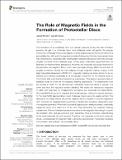Files in this item
The role of magnetic fields in the formation of protostellar discs
Item metadata
| dc.contributor.author | Wurster, J. | |
| dc.contributor.author | Li, Zhi-Yun | |
| dc.date.accessioned | 2019-10-25T10:30:04Z | |
| dc.date.available | 2019-10-25T10:30:04Z | |
| dc.date.issued | 2018-12-13 | |
| dc.identifier | 262320843 | |
| dc.identifier | ce6b1926-d784-42c4-9efc-7d420226a9d9 | |
| dc.identifier | 85074520309 | |
| dc.identifier.citation | Wurster , J & Li , Z-Y 2018 , ' The role of magnetic fields in the formation of protostellar discs ' , Frontiers in Astronomy and Space Sciences , vol. 5 , 39 , pp. 1-19 . https://doi.org/10.3389/fspas.2018.00039 | en |
| dc.identifier.issn | 2296-987X | |
| dc.identifier.other | Bibtex: WursterLi2018 | |
| dc.identifier.uri | https://hdl.handle.net/10023/18769 | |
| dc.description.abstract | The formation of a protostellar disc is a natural outcome during the star formation process. As gas in a molecular cloud core collapses under self-gravity, the angular momentum of the gas will slow its collapse on small scales and promote the formation of a protostellar disc. Although the angular momenta of dense star-forming cores remain to be fully characterized observationally, existing data indicates that typical cores have enough angular momenta to form relatively large, 100 au-scale, rotationally supported discs, as illustrated by hydrodynamic simulations. However, the molecular clouds are observed to be permeated by magnetic fields, which can in principle strongly affect the evolution of angular momentum during the core collapse through magnetic braking. Indeed, in the ideal magnetohydrodynamic (MHD) limit, magnetic braking has been shown to be so efficient as to remove essentially all of the angular momentum of the material close to the forming star such that disc formation is suppressed. This failure to produce discs in idealized cores is known as the magnetic braking catastrophe. The catastrophe must be averted in order for the all-important rotationally supported discs to appear, but when and how this happens remains debated. We review the resolutions proposed to date, with emphasis on misalignment, turbulence and especially non-ideal effects. Non-ideal MHD accounts for charged and neutral species, making it a natural extension to the ideal MHD approximation, since molecular clouds are only weakly ionized. The dissipative non-ideal effects diffuse the magnetic field to weaken it, and the dispersive term redirects the magnetic field to promote or hinder disc formation, dependent upon the magnetic geometry. When self-consistently applying non-ideal processes, rotationally supported discs of at least tens of au form, thus preventing the magnetic braking catastrophe. The non-ideal processes are sensitive to the magnetic field strength, cosmic ray ionization rate, and gas and dust grain properties, thus a complete understanding of the host molecular cloud is required. Therefore, the properties of the host molecular cloud—and especially its magnetic field—cannot be ignored when numerically modeling the formation and evolution of protostellar discs. | |
| dc.format.extent | 19 | |
| dc.format.extent | 4108842 | |
| dc.language.iso | eng | |
| dc.relation.ispartof | Frontiers in Astronomy and Space Sciences | en |
| dc.subject | Magnetic Fields | en |
| dc.subject | Magnetohdyrodynamics (MHD) | en |
| dc.subject | Non-ideal MHD | en |
| dc.subject | Star formation | en |
| dc.subject | Protostellar discs | en |
| dc.subject | QB Astronomy | en |
| dc.subject | QC Physics | en |
| dc.subject | 3rd-DAS | en |
| dc.subject.lcc | QB | en |
| dc.subject.lcc | QC | en |
| dc.title | The role of magnetic fields in the formation of protostellar discs | en |
| dc.type | Journal item | en |
| dc.contributor.institution | University of St Andrews. School of Physics and Astronomy | en |
| dc.identifier.doi | 10.3389/fspas.2018.00039 | |
| dc.description.status | Peer reviewed | en |
| dc.identifier.url | https://arxiv.org/abs/1812.06728 | en |
This item appears in the following Collection(s)
Items in the St Andrews Research Repository are protected by copyright, with all rights reserved, unless otherwise indicated.

